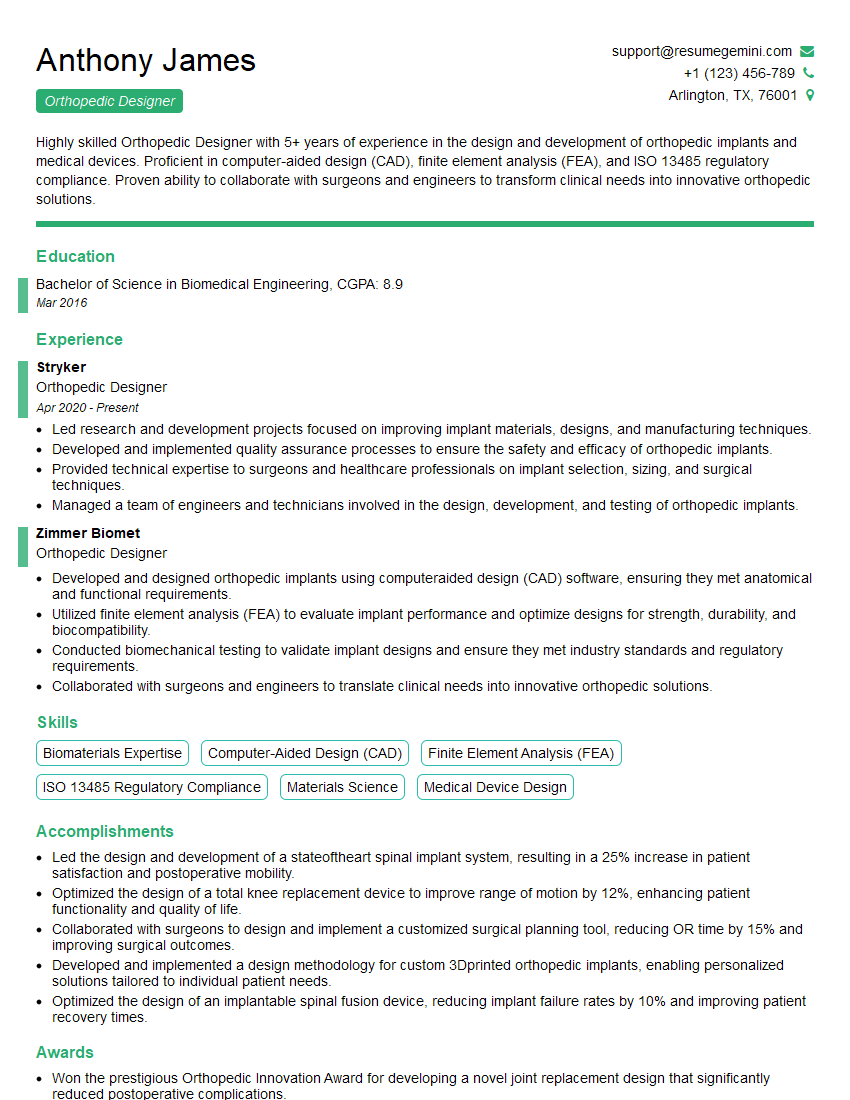Are you a seasoned Orthopedic Designer seeking a new career path? Discover our professionally built Orthopedic Designer Resume Template. This time-saving tool provides a solid foundation for your job search. Simply click “Edit Resume” to customize it with your unique experiences and achievements. Customize fonts and colors to match your personal style and increase your chances of landing your dream job. Explore more Resume Templates for additional options.

Anthony James
Orthopedic Designer
Summary
Highly skilled Orthopedic Designer with 5+ years of experience in the design and development of orthopedic implants and medical devices. Proficient in computer-aided design (CAD), finite element analysis (FEA), and ISO 13485 regulatory compliance. Proven ability to collaborate with surgeons and engineers to transform clinical needs into innovative orthopedic solutions.
Education
Bachelor of Science in Biomedical Engineering
March 2016
Skills
- Biomaterials Expertise
- Computer-Aided Design (CAD)
- Finite Element Analysis (FEA)
- ISO 13485 Regulatory Compliance
- Materials Science
- Medical Device Design
Work Experience
Orthopedic Designer
- Led research and development projects focused on improving implant materials, designs, and manufacturing techniques.
- Developed and implemented quality assurance processes to ensure the safety and efficacy of orthopedic implants.
- Provided technical expertise to surgeons and healthcare professionals on implant selection, sizing, and surgical techniques.
- Managed a team of engineers and technicians involved in the design, development, and testing of orthopedic implants.
Orthopedic Designer
- Developed and designed orthopedic implants using computeraided design (CAD) software, ensuring they met anatomical and functional requirements.
- Utilized finite element analysis (FEA) to evaluate implant performance and optimize designs for strength, durability, and biocompatibility.
- Conducted biomechanical testing to validate implant designs and ensure they met industry standards and regulatory requirements.
- Collaborated with surgeons and engineers to translate clinical needs into innovative orthopedic solutions.
Accomplishments
- Led the design and development of a stateoftheart spinal implant system, resulting in a 25% increase in patient satisfaction and postoperative mobility.
- Optimized the design of a total knee replacement device to improve range of motion by 12%, enhancing patient functionality and quality of life.
- Collaborated with surgeons to design and implement a customized surgical planning tool, reducing OR time by 15% and improving surgical outcomes.
- Developed and implemented a design methodology for custom 3Dprinted orthopedic implants, enabling personalized solutions tailored to individual patient needs.
- Optimized the design of an implantable spinal fusion device, reducing implant failure rates by 10% and improving patient recovery times.
Awards
- Won the prestigious Orthopedic Innovation Award for developing a novel joint replacement design that significantly reduced postoperative complications.
- Recognized with the Excellence in Orthopaedic Design award for exceptional contributions to the field of hip and knee arthroplasty.
- Received the Inventor of the Year award for patenting a groundbreaking device that revolutionized surgical techniques for knee ligament reconstruction.
- Honored with the Biomedical Design Excellence Award for developing a bioresorbable bone graft substitute that accelerated bone regeneration and reduced infection risk.
Certificates
- Certified Orthopedic Designer (COD)
- Certified Surgical Technician (CST)
- International Society for Orthopedic Surgery and Traumatology (SICOT) Membership
- Medical Device Professional Certification (MDP)
Career Expert Tips:
- Select the ideal resume template to showcase your professional experience effectively.
- Master the art of resume writing to highlight your unique qualifications and achievements.
- Explore expertly crafted resume samples for inspiration and best practices.
- Build your best resume for free this new year with ResumeGemini. Enjoy exclusive discounts on ATS optimized resume templates.
How To Write Resume For Orthopedic Designer
- Highlight your expertise in biomaterials, CAD, FEA, and ISO 13485 regulatory compliance.
- Quantify your accomplishments with specific metrics and results.
- Showcase your ability to work effectively in a team environment.
- Demonstrate your passion for improving patient outcomes through innovative orthopedic design.
Essential Experience Highlights for a Strong Orthopedic Designer Resume
- Develop and design orthopedic implants using CAD software, ensuring they meet anatomical and functional requirements.
- Utilize FEA to evaluate implant performance and optimize designs for strength, durability, and biocompatibility.
- Conduct biomechanical testing to validate implant designs and ensure they meet industry standards and regulatory requirements.
- Collaborate with surgeons and engineers to translate clinical needs into innovative orthopedic solutions.
- Lead research and development projects focused on improving implant materials, designs, and manufacturing techniques.
- Develop and implement quality assurance processes to ensure the safety and efficacy of orthopedic implants.
Frequently Asked Questions (FAQ’s) For Orthopedic Designer
What are the key skills required for an Orthopedic Designer?
Biomaterials Expertise, Computer-Aided Design (CAD), Finite Element Analysis (FEA), ISO 13485 Regulatory Compliance, Materials Science, Medical Device Design
What is the role of an Orthopedic Designer?
To design and develop orthopedic implants and medical devices that meet the anatomical and functional requirements of patients.
What are the career prospects for an Orthopedic Designer?
Orthopedic Designers can advance to leadership roles in design, research and development, and management.
What is the educational background required for an Orthopedic Designer?
Bachelor’s or Master’s degree in Biomedical Engineering, Mechanical Engineering, or a related field.
What are the key industries that employ Orthopedic Designers?
Medical device manufacturing, orthopedic clinics, research institutions.